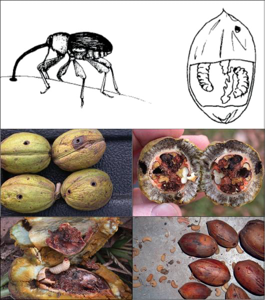Now Is the Time to Save Your Pecans From Weevil Damage
go.ncsu.edu/readext?948033
en Español / em Português
El inglés es el idioma de control de esta página. En la medida en que haya algún conflicto entre la traducción al inglés y la traducción, el inglés prevalece.
Al hacer clic en el enlace de traducción se activa un servicio de traducción gratuito para convertir la página al español. Al igual que con cualquier traducción por Internet, la conversión no es sensible al contexto y puede que no traduzca el texto en su significado original. NC State Extension no garantiza la exactitud del texto traducido. Por favor, tenga en cuenta que algunas aplicaciones y/o servicios pueden no funcionar como se espera cuando se traducen.
Português
Inglês é o idioma de controle desta página. Na medida que haja algum conflito entre o texto original em Inglês e a tradução, o Inglês prevalece.
Ao clicar no link de tradução, um serviço gratuito de tradução será ativado para converter a página para o Português. Como em qualquer tradução pela internet, a conversão não é sensivel ao contexto e pode não ocorrer a tradução para o significado orginal. O serviço de Extensão da Carolina do Norte (NC State Extension) não garante a exatidão do texto traduzido. Por favor, observe que algumas funções ou serviços podem não funcionar como esperado após a tradução.
English
English is the controlling language of this page. To the extent there is any conflict between the English text and the translation, English controls.
Clicking on the translation link activates a free translation service to convert the page to Spanish. As with any Internet translation, the conversion is not context-sensitive and may not translate the text to its original meaning. NC State Extension does not guarantee the accuracy of the translated text. Please note that some applications and/or services may not function as expected when translated.
Collapse ▲How many times have you picked up pecans only to find a small hole near the end of the shell and empty? If you grow pecans, my guess is too many. If you have experienced this damage in the previous two years, you will likely see the same damage again this year unless you take proactive measures now.
The culprit behind this damage is the pecan weevil, a beetle with a long slender snout and thin legs. They are reddish brown and about the size of a pencil eraser. The female weevil punctures the shell in mid to late August and lays an egg inside the developing nut. Once the egg hatches, the larva begin to feed on the nut and grow. This is typically the time that the nut falls off the tree and onto the ground. Once the larva has finished eating your delicious pecan, it chews a hole through the nut shell, exits, and buries itself in the soil. The larva, or grub, will then live in the soil for one to two years. To complete the life cycle, the grub will pupate and emerge from the soil as adults and begin to search for developing nuts.
To control pecan weevil larvae and adults, a good practice is to apply any liquid carbaryl product (Sevin) to the ground underneath the pecan tree out to the drip-line. Begin in mid-August and make applications weekly through mid-September. If you don’t feel comfortable with this many pesticide applications, you can monitor the tree for weevil populations and spray when the adults are detected. Once adult activity is detected, you can begin applications of carbaryl on the tree trunk, in the branches, and on the ground. However, this method may not provide full protection against the weevil larvae.
An easy way to monitor for pecan weevils is to tie a burlap cloth around the trunk of the trees in layers and check daily for weevil activity. You will be able to see the adult pecan weevils climbing up the burlap cloth towards the developing pecans. It is also a good practice to monitor pecans that fall from the tree and discard any with damage. This will prevent any larvae from completing their life cycle.
Remember to read and follow all labels and labeling instructions when using any pesticide. Follow all recommendations for mixing and application rates to prevent any harm to the environment. Finally, be sure to utilize all the personal protection equipment required to prevent any injury or harm to yourself.
To learn more, you can view or download the N.C. Cooperative Extension publication, Growing Pecans in NC, available online, or contact the Extension Master Gardeners℠ of Sampson County.




